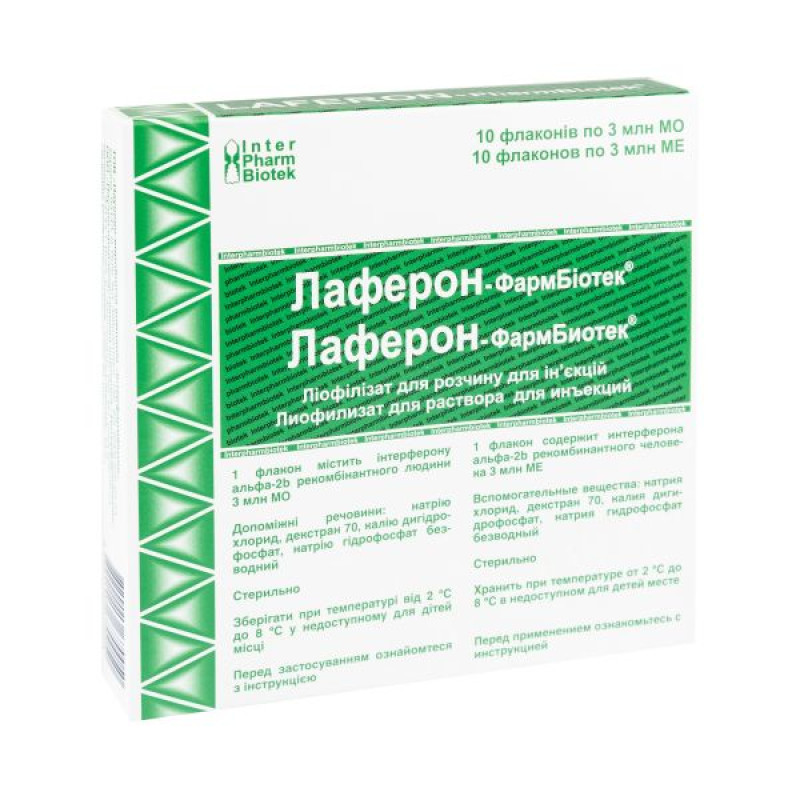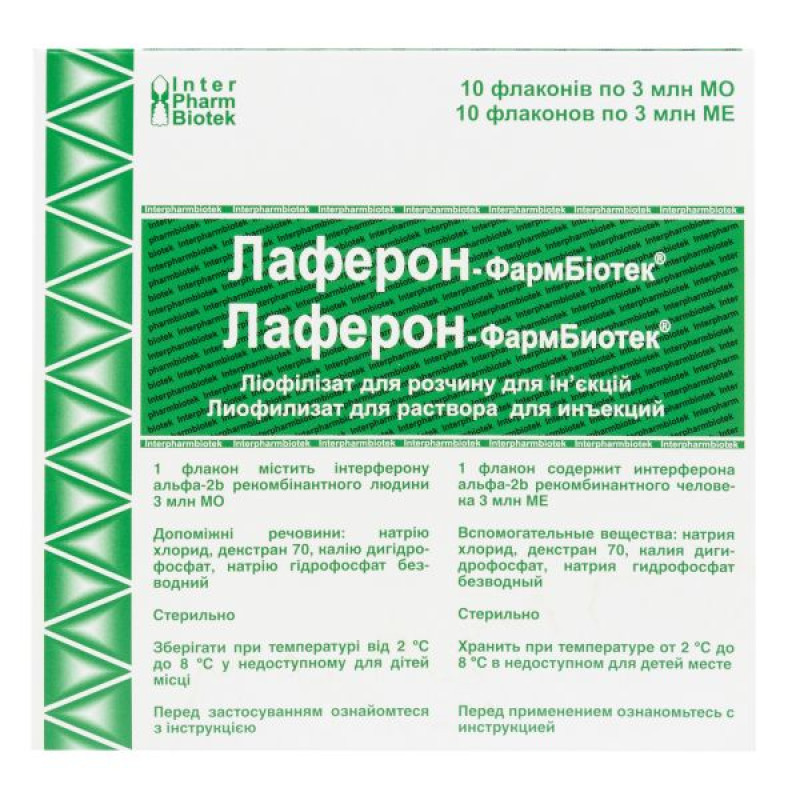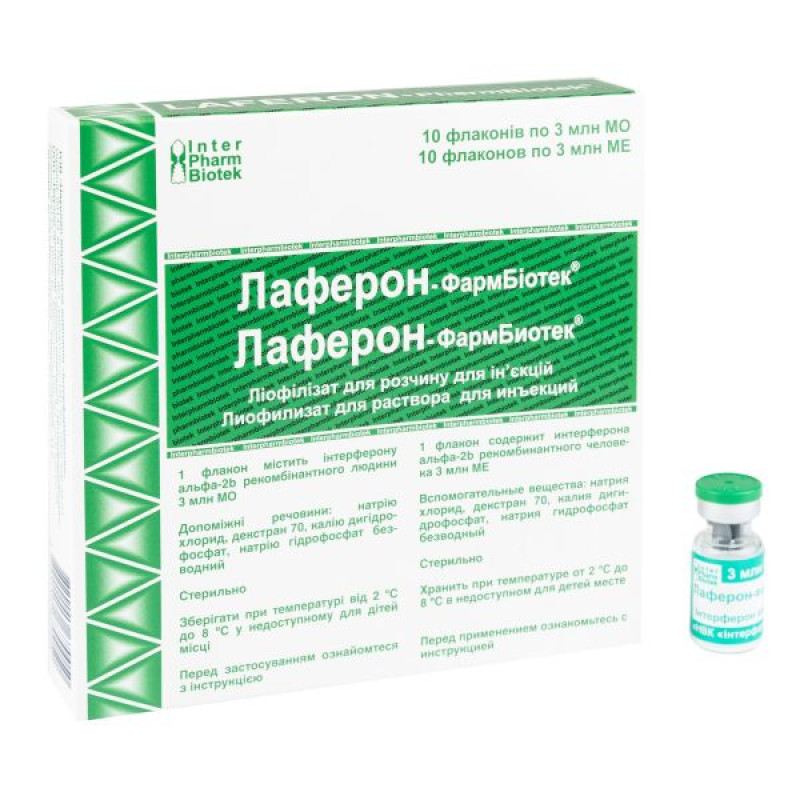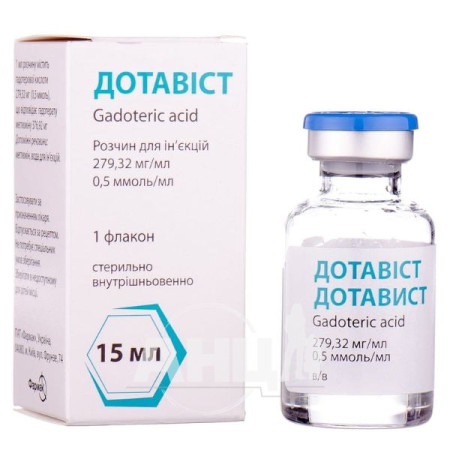Laferon-PharmBiotek lyophilized powder for solution for injection 3000000 IU vial No. 10

Instructions Laferon-PharmBiotek lyophilized powder for solution for injection 3000000 IU vial No. 10
Composition
active ingredient: recombinant human interferon alpha-2b, activity in each vial 1 million, 3 million, 5 million, 6 million, 9 million, 18 million IU;
excipients: sodium chloride, dextran 70, potassium dihydrogen phosphate, sodium hydrogen phosphate anhydrous.
Dosage form
Lyophilisate for solution for injection.
Main physicochemical properties: lyophilized powder or porous mass of white color, hygroscopic.
Pharmacotherapeutic group
Immunostimulants. Interferon alpha-2b. ATX code L03A B05.
Pharmacological properties
Pharmacodynamics
Recombinant human interferon alpha-2b is a highly purified water-soluble protein with a molecular weight of 19,300 daltons.
Laferon-PharmBiotech®, like natural leukocyte interferon, has three main types of biological activity: immunomodulatory, antiviral, and antitumor.
The mechanism of action of Laferon-PharmBiotech® is based on the fact that interferon, binding to the corresponding receptors of the body's cells, induces a complex of intracellular mechanisms, which leads to the appearance of enzymes that prevent virus replication, increase the phagocytic activity of macrophages, specific cytotoxicity of lymphocytes to target cells, and inhibit the proliferation of metastasizing cells.
Pharmacokinetics
Data is missing.
Indication
Laferon-PharmBiotec® is used in complex therapy for:
– acute and chronic viral hepatitis B (moderate and severe forms);
– chronic hepatitis C;
– acute viral, bacterial and mixed infections (including acute respiratory viral infection in children, including newborns, acute diarrheal syndrome in newborns, acute intestinal infections in young children with hypocoagulation phenomena);
– acute and chronic septic diseases of viral and bacterial nature, including disseminated forms of acute and chronic sepsis;
– herpetic infections of various localization: shingles, multiple skin herpetic rashes; genital herpetic infection; herpetic keratoconjunctivitis and keratouveitis, acute herpetic stomatitis in children;
– chronic urogenital chlamydiosis;
– nervous system lesions with mono- and polyradicular pain syndromes;
– multiple sclerosis;
– laryngeal papillomatosis;
– melanoma of the skin and eye; kidney, bladder, ovarian, breast cancer; Kaposi's sarcoma, myeloma; chronic myeloid leukemia, hairy cell leukemia, non-Hodgkin's malignant lymphomas, basal cell carcinoma; T-cell lymphoma of the skin (mycosis fungoides).
Contraindication
– Hypersensitivity to interferon alfa-2b or to other components of the drug;
– severe diseases of the cardiovascular system (including heart failure in the decompensation stage, recent myocardial infarction, severe arrhythmia);
– severe kidney or liver dysfunction;
– epilepsy and/or CNS dysfunction (including functional);
– chronic hepatitis with decompensated cirrhosis of the liver;
– chronic hepatitis in patients who are undergoing or have recently undergone treatment with immunosuppressive drugs, except for a short course of corticosteroid therapy;
– autoimmune hepatitis or a history of autoimmune disease;
– the patient has thyroid dysfunction;
– the presence of severe visceral disorders in patients with Kaposi's sarcoma;
– psoriasis;
– pregnancy (threat of miscarriage).
Interaction with other medicinal products and other types of interactions
Since interferon alpha alters cellular metabolism, there is a potential for modification of the action of other drugs. It may alter oxidative metabolic processes, which should be considered when co-administering drugs that are metabolized by this pathway (cimetidine, phenytoin, warfarin, theophylline, aminophylline, diazepam, propranolol). Theophylline serum concentrations should be monitored and the dosage regimen adjusted if necessary.
The drug should be used with caution simultaneously with opioid drugs, analgesics, hypnotics and sedatives (potentially causing a myelosuppressive effect).
When using the drug in combination with chemotherapeutic drugs (cytarabine, doxorubicin, teniposide, cyclophosphamide), the risk of developing life-threatening toxic effects (their severity and duration) increases.
Synergism of side effects (with respect to white blood cell count) has been described with the combined administration of interferon alfa and zidovudine. In patients receiving these drugs simultaneously, the incidence of neutropenia was higher than in those treated with zidovudine alone.
Application features
If the side effect does not subside or worsens, the dose of the drug is reduced to 50% or treatment is discontinued. Depending on the individual sensitivity and the prescribed dose of the drug, patients may experience a slowed psychomotor reaction rate - drowsiness, weakness, increased fatigue.
During treatment with the drug, alcohol consumption should be avoided.
Before prescribing the drug for a long time in doses of 3 million IU and above, it is recommended to study the thyroid function. The drug can be started on condition that the level of thyroid-stimulating hormone (TSH) is within normal limits. If changes in the level of TSH are detected, appropriate therapy should be carried out and treatment with Laferon-PharmBiotec® should be started on condition that the TSH content can be maintained at a normal level. It is also advisable to monitor the TSH level during treatment.
After discontinuation of therapy, thyroid function, which is impaired as a result of drug administration, is not restored.
All patients should undergo a comprehensive peripheral blood count before starting and regularly during treatment, with mandatory qualitative and quantitative blood tests, as well as a biochemical blood test, including determination of electrolytes, calcium, liver enzymes, and creatinine.
In myeloma disease, periodic monitoring of kidney function is necessary.
Serum albumin levels and prothrombin time should be closely monitored in all patients receiving the drug.
In patients after organ or bone marrow transplantation, drug immunosuppression may be less effective because interferons have a stimulating effect on the immune system.
The drug should be prescribed with caution in patients with a history of diseases such as diabetes mellitus with episodes of ketoacidosis and chronic obstructive pulmonary disease, with blood clotting disorders, and with severe myelosuppression.
During treatment with the drug, it is necessary to ensure adequate hydration of the body; in case of fever, other causes of its occurrence should be excluded.
It is recommended to use the drug against the background of antihistamine and antipyretic therapy.
There is no evidence of direct cardiotoxicity of interferon, but there is a possibility that the presence of hyperthermia and chills, which often accompany treatment, may exacerbate existing heart disease. In the presence of a history of chronic heart failure, myocardial infarction and / or previous or existing arrhythmias, treatment with interferon alfa-2b should be carried out under strict medical supervision.
When performing combination therapy with ribavirin, precautions for ribavirin should be taken into account.
The use of the drug during pregnancy is justified only if the benefit of the therapy outweighs the possible risk to the fetus.
If an immediate-type hypersensitivity reaction develops (urticaria, angioedema, bronchospasm, anaphylaxis), the drug should be immediately discontinued and appropriate measures taken.
Discontinue use of the drug in cases of: prolonged blood clotting time (in patients with chronic hepatitis), manifestations of pulmonary syndrome and radiological detection of infiltrate, appearance or increase in visual impairment, thyroid dysfunction (deviation from the norm of TSH), decreased serum albumin levels and decreased prothrombin time.
The product does not contain preservatives, therefore, to avoid bacterial contamination, it is recommended to use the parenteral solution immediately.
Use during pregnancy or breastfeeding
The use of the drug is contraindicated during pregnancy or breastfeeding.
Ability to influence reaction speed when driving vehicles or other mechanisms
Depending on the dose, regimen, and individual sensitivity to interferon alpha, treatment may be accompanied by drowsiness, weakness, fatigue, and lead to a decrease in the speed of psychomotor reactions.
Method of administration and doses
Laferon-PharmBiotec® solution is administered intramuscularly, subcutaneously, intravenously, endolymphally, intraperitoneally, intravesically, rectally, parabulbarly, intranasally.
Acute viral hepatitis B:
– administer intramuscularly 1 million IU (in severe cases – 2 million IU) 2 times a day for 10 days. Such a course can be prolonged to 2-3 weeks depending on the clinical status of the patient or continued by 1 million IU 2 times a week for several weeks.
Chronic viral hepatitis B:
– administer intramuscularly 3-4 million IU 3 times a week for 2 months.
Chronic viral hepatitis C:
Acute respiratory viral infection in children, including newborns:
– inject intranasally 2-3 drops into each nasal passage 3-6 times a day for 3-5 days; dosage of the drug for newborns – 20-50 thousand IU/ml, for other children – 100 thousand IU/ml. It is permissible to insert cotton turundas moistened with Laferon-PharmBiotec® into the nasal passages (in turn) for 10-15 minutes.
Acute respiratory viral infection (including influenza) in adults:
– administer 1-3 million IU intramuscularly, starting from day 1-2 of the disease for 3 days;
– intranasally, 4-6 drops of Laferon-PharmBiotec® solution (100 thousand IU/ml) into each nasal passage 6-8 times a day (before using the dose of Laferon-PharmBiotec® that is being poured, it should be warmed in a syringe (use a syringe without a needle) to body temperature, the remaining solution should be stored in the refrigerator, preventing bacterial contamination).
Acute and recurrent pneumonia of viral and viral-bacterial etiology:
– Laferon-PharmBiotech® should be administered intramuscularly at 1 million IU for 5-7 days together with comprehensive treatment (antibacterial, detoxification, anti-inflammatory, etc.).
Acute diarrheal syndrome in newborns:
– rectally in the form of daily microenemas containing 100 thousand IU of Laferon-PharmBiotec®, for 3-7 days.
Acute intestinal infections in young children with hypocoagulation phenomena:
– rectally, at a dose of 10 thousand IU/kg of body weight three times with an interval of 48 hours.
Purulent-septic diseases, peritonitis, multiple abscesses of the abdominal cavity:
– intravenously 2-4 million IU once a day; total dose 12-16 million IU per course; the feasibility of simultaneous endolymphatic administration of the drug in the same dose is not excluded: 2-4 million IU once a day.
Herpetic infections:
– shingles: daily 1 million IU intramuscularly + 2 million IU in 5 ml of 0.9% sodium chloride solution subcutaneously at several points around the rash area. Duration of treatment 5-7 days;
– cutaneous herpetic eruptions: daily intramuscular or subcutaneous (around the lesion) administration of the drug at a dose of 2 million IU; treatment can be combined with local application (applications) to herpetic papules; the duration of treatment is determined by the doctor;
– genital herpes infection: daily intramuscular injection at a dose of 2 million IU in combination with local application of the drug in the form of applications in the area of the rashes; the duration of treatment is determined by the doctor;
– herpetic keratoconjunctivitis: application of a solution of Laferon-PharmBiotec® – 1 million IU in 5 ml of 0.9% sodium chloride solution – under the conjunctiva of the eye, 2-3 drops every 2 hours for 7-10 days; with the disappearance of the symptoms of the disease, the drug can be applied every 4 hours; the duration of treatment is determined by the doctor;
– acute herpetic stomatitis in children: 250 thousand IU per dose 4 times a day in the form of applications in combination with intranasal administration. Laferon-PharmBiotec® 1 million IU diluted in 4 ml of water for injection, use 1 ml of solution per 1 application and intranasal administration: 2 drops administered intranasally, the rest - after hygienic treatment of the oral mucosa, apply locally in the form of applications. The course of treatment is 7-10 days.
Chronic urogenital chlamydia:
Treatment of patients with urogenital chlamydia is carried out in 2 stages:
– 1st stage – preparatory, which includes the use of enterosorbent, multivitamin preparations in therapeutic doses for 2 weeks. From the 10th day, the immunotropic drug Thymalin is prescribed at 10 mg intramuscularly in the evening every other day, the course is 5 injections;
– 2nd stage – the main one, during which basic therapy with antibacterial agents is carried out according to the following scheme: the first antibiotic for 5 days; after a break lasting 7 days, the patient is prescribed a second antibiotic for 10 days. During the break and after the end of the course of antibacterial therapy, Laferon-PharmBiotec® is prescribed 1 million IU intramuscularly 1 time per day in the evening, a total of 10 injections per course.
While taking antibacterial agents, it is necessary to use antifungal drugs (nystatin, diflucan, clotrimazole, nizoral) and hepatoprotectors (carsil) in therapeutic doses.
Nervous system damage with mono- and polyradicular pain syndromes:
– intramuscularly at a dose of 1 million IU for a course of 5-10 days in complex treatment.
Laryngeal papillomatosis:
– 3 million IU/m2 subcutaneously 3 times a week (every other day) for 6 months or more; adjust the dose based on drug tolerability. Treatment should be initiated after surgical (laser) removal of tumor tissue.
Multiple sclerosis:
– intramuscularly 1 million IU 2-3 times a day for 10-15 days, followed by the introduction of 1 million IU once a week for 6 months.
Melanoma of the skin:
– as an adjunct to surgical treatment and for induction of remission intravenously 20 million IU/m2 (infusion over 20 minutes), 5 times a week for 4 weeks; maintenance therapy – subcutaneously 10 million IU/m2 3 times a week (every other day) for 48 weeks.
If severe side effects develop, namely, a decrease in the number of granulocytes (less than 500/mm3), an increase in ALT/AST (5 times the upper limit of normal), the drug should be discontinued until the indicators normalize. Treatment should be resumed at half the dose. If intolerance persists and the number of granulocytes decreases to 250/mm3 or the activity of ALT and/or AST increases (10 times the upper limit of normal), the drug should be discontinued.
– parabulbar daily 1 million IU for 10 days; repeated 10-day administrations are carried out twice after 20 days; the total course of Laferon-PharmBiotec® is 48 weeks. The need for repeated courses after 45 days is not excluded; treatment with Laferon-PharmBiotec® is combined with photodestruction of the tumor and beta-application.
Kidney cancer:
– as induction therapy, 10 million IU/m2 (up to 18 million IU/m2 per day) intramuscularly or subcutaneously; the indicated doses should be achieved by increasing the previous dose by 3 million IU/m2 every 3 days (the first 3 days – 3 million IU/m2, the second 3 days – 6 million IU/m2, the third 3 days – 9 million IU/m2, etc. up to 18 million IU/m2); doses should be adjusted taking into account the tolerability of the drug; with good tolerability, the maximum dose is 36 million IU/m2; the duration of induction therapy is 3 months, after which the issue of drug withdrawal or continuation of treatment should be decided in the presence of remission or stabilization of the condition. In maintenance treatment, the drug should be administered in the same doses 3 times a week for at least 6 months.
Bladder cancer:
– intravesically from 30 million IU to 50 million IU weekly for 8-12 weeks; for carcinoma in situ, 60-100 million IU per instillation weekly for 12 weeks. Before administering the drug, the patient should refrain from taking fluids for 8 hours. Before administering the drug, the bladder should be emptied. The drug should be injected with a sterile syringe through a catheter into the bladder cavity, where it should remain for 2 hours, while the patient should change body position every 15 minutes (for better interaction of the drug with the bladder mucosa). After 2 hours, the bladder should be emptied.
Ovarian cancer:
– intraperitoneally during surgery and in the next 5 days – into the drainage – 5 million IU; further administration of Laferon-PharmBiotec® – intramuscularly 3 million IU for 10 days between chemotherapy courses; the total dose of Laferon-PharmBiotec® is 90 million IU. Subsequent courses can be prescribed with an interval of 2-3 months for 1-1.5 years: 3 million IU daily for 10 days.
Breast cancer:
– intramuscularly, daily for 10 days, 3 million IU per injection. Repeated courses are carried out for 1 year with an interval of 1.5-2 months, and then 2-3 months (depending on the clinical status); it is advisable to alternate courses of therapy with Laferon-PharmBiotec® with courses of chemotherapy (or radiation therapy).
Kaposi's sarcoma: the following treatment regimens are possible:
– intramuscularly daily for 10 days, 3 million IU per injection; treatment is combined with monochemotherapy with prospidin; repeated courses – once a month for 6 months;
– intravenously drip over 30 minutes at 50 million IU (30 million IU/m2) daily for 5 days or with an interval of 1 day, after which a minimum 9-day break is required before starting a new 5-day course; the duration of treatment is determined by the doctor.
Myeloma disease:
– intramuscularly, daily for 10 days, 3 million IU per injection, repeated courses – once every 1.5-3 months (4-6 times during the year).
Chronic myeloid leukemia:
– subcutaneously 3 million IU/m2 per day daily or once every 2 days, gradually increasing the dose to 5 million IU/m2 per day daily or once every 2 days under the supervision of a physician until complete hematological remission is achieved (the number of leukocytes in peripheral blood is no more than 10×109/l) or for 18 months.
Hairy cell leukemia:
– intramuscularly 3 million IU 3 times a week (every other day) for 4-6 weeks. When remission is achieved, maintenance therapy is performed: 3 million IU every other day for up to 12 months.
Non-Hodgkin's malignant lymphomas:
– intramuscularly 3 million IU 3 times a week for 12-18 months as maintenance therapy when achieving remission obtained as a result of chemotherapy. During the period of partial remission, the use of other chemotherapy protocols is indicated with subsequent therapy with Laferon-PharmBiotec® 3 million IU intramuscularly 3 times a week for 18 months.
Basal cell carcinoma:
– 10 million IU (dissolved in 1 ml of water for injection) – into the base and into the middle of the tumor (using a 1 ml syringe); if the lesion area is less than 2 cm2, inject 0.15 ml of the drug solution (1.5 million IU) 3 times a week (every other day) for 3 weeks; the total dose should not exceed 13.5 million IU; if the lesion area is from 2 to 10 cm2, the drug dose should be 0.5 million IU/cm2 (but not less than 15 million IU in the first injection); inject 3 times a week for 3 weeks; treat one lesion area at a time; in the absence of positive dynamics (appearance, lesion size, degree of redness, biopsy data) after 2-3 months of treatment, consider surgical treatment of the disease.
T-cell lymphoma (mycosis fungoides) in the ulcerative stage:
– intradermally (into the superficial layer of the dermis, below the spot or ulcer) 1-2 million IU (dissolved in 0.5 ml of water for injection) 3 times a week for 4 weeks; before administration, treat the affected area with a cotton swab with alcohol; administer the drug solution with a thin needle (30 gauge), using a 1 ml syringe; during administration, the needle should be in an almost parallel position to the body surface; deeper - subcutaneous - administration should be avoided.
Preparation of the drug solution.
If the drug solution is prepared for intraperitoneal or intravesical administration, use 0.9% sodium chloride solution as a solvent (which should be taken so that the concentration of the drug Laferon-PharmBiotec® is at least 0.3 million IU/ml).
Preparation and administration of intravenous infusion of the drug.
30 minutes before the start of the infusion of Laferon-PharmBiotec®, start the infusion of 0.9% sodium chloride solution (at a rate of 200 ml/h) and finish it immediately before the administration of the drug. To prepare the infusion solution, Laferon-PharmBiotec® should first be dissolved in water for injection (at the rate of 1 ml of water for injection per dose of the drug to be administered), then the required amount of the drug should be taken and added to 50 ml of 0.9% sodium chloride solution; the prepared solution should be administered intravenously drip for 30 minutes. After the end of the administration of Laferon-PharmBiotec®, the infusion of 0.9% sodium chloride solution should be continued at a rate of 200 ml/h for 10 minutes.
The solution for injection should be used immediately. For intranasal use, the solution should be used within 1 day if stored at 2 to 8 °C.
Children.
It is used in pediatric practice for acute respiratory viral infections in children, including newborns, acute diarrheal syndrome in newborns, acute intestinal infections in young children with hypocoagulation phenomena, acute herpetic stomatitis in children (see the section "Method of administration and dosage").
Overdose
To date, no cases of overdose with Laferon-PharmBiotec® have been described. However, as with overdose with any medicinal substance, symptomatic therapy is recommended with monitoring of vital organ functions and careful observation of the patient's condition.
Adverse reactions
Injection of Laferon-PharmBiotec®, as well as all other alpha-interferon preparations, is in most cases accompanied by a flu-like syndrome characterized by fever, chills, headache, muscle pain, joint pain, and lethargy. These side effects are dose-dependent and, as a rule, occur only in the first days of treatment, then weaken and disappear. These symptoms can be stopped or significantly reduced by prescribing paracetamol at a dose of 0.5-1 g 30-40 minutes before the injection. Vomiting, dizziness, and hot flashes may rarely occur.
From the cardiovascular system: possible hypo- or hypertension, tachycardia.
Skin and subcutaneous tissue disorders: alopecia.
Allergic reactions, including rashes (including herpetic), itching, hyperemia, urticaria, anaphylactic shock.
On the part of the endocrine system: thyroid dysfunction.
Possible development of visual disturbances; electrolyte balance, liver and kidney function.
With long courses, leuko- and thrombocytopenia may be observed, which are eliminated by reducing the dose, nosebleeds; mental disorders - confusion, anxiety and depressive states, increased excitability, drowsiness; disorders of the central and peripheral nervous system - ataxia, paresthesias; disorders of the respiratory system - cough.
Expiration date
3 years.
Storage conditions
Store at a temperature of 2 to 8 °C out of the reach of children.
Packaging
Lyophilisate for solution for injection 1 million IU, 3 million IU, 5 million IU in vials No. 10 in a cardboard box.
Lyophilisate for solution for injection 1 million IU, 3 million IU, 5 million IU in vials No. 5 complete with solvent (water for injection in ampoules No. 5) in a cardboard box.
Lyophilisate for solution for injection 3 million IU, 5 million IU, 6 million IU, 9 million IU, 18 million IU in vials No. 1 complete with solvent (water for injection in ampoules No. 1) in a cardboard box.
Vacation category
According to the recipe.
Producer
LLC "Research and Production Company "Interpharmbiotech".
Location of the manufacturer and its business address
Ukraine, 03680, Kyiv, Zabolotnogo St., 150.
There are no reviews for this product.
There are no reviews for this product, be the first to leave your review.
No questions about this product, be the first and ask your question.


















